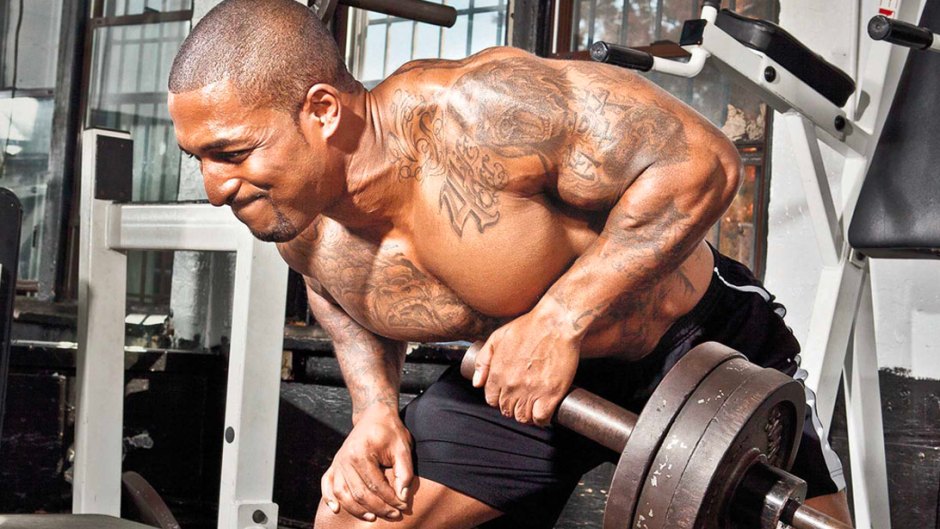
The single-arm row is often thought of as the poor cousin of bilateral rows. Then the Meadows row came along. This row variation allows you to go hard and heavy without being inhibited by big and bulky dumbbells. The late John Meadows, a former IFBB bodybuilder and head coach of Mountain Dog, came up with this great variation, hence the name. The Meadows row uses a landmine set up that hammers the upper back, your grip, and the hard-to-reach lower lats.
MEADOWS ROW EXPLAINED
The Meadows row is a unilateral row performed with a landmine setup, overhand grip, and staggered stance. The angle of the landmine and gripping the fat end of the barbell reduces shoulder joint stress while maximizing shoulder, upper back, and lat tension. Staggering your stance with a slight incline (because your back hip is up) trains the upper back hard and heavy as well as the lower lats.
This type of landmine row, along with other variations, makes you work harder by forcing you to grip the fat end of the barbell. This improves your shoulder stability because your rotator cuff is engaged. This is a great variation if your shoulders are bothering you.
HOW TO DO THE MEADOWS ROW EXERCISE
- Stand in a staggered stance with the front foot horizontal to the landmine set-up
- Lean your torso forward and grip the barbell.
- Rest the other forearm on the forward leg.
- Hike up the closest hip to the bar up higher than the other hip as this stretches the lower lats.
- Start this movement by driving the elbow behind you while retracting the shoulder-blade. Keep the working shoulder down.
- Pull toward your back hip until the elbow is level with your torso.
- Slowly lower down until your elbow is straight and reset and repeat.
MUSCLES WORKED FROM MEADOWS ROW
The Meadows row is a unilateral exercise performed in a modified hinge position. Because of this, both the lower and the upper body is trained. The Meadows row works these muscles:
UPPER BODY:
- Forearms
- Biceps
- Posterior deltoids
- Rhomboids
- Middle traps
- Rotator cuff
- Lats
LOWER BODY:
- Erector Spinae (lower back)
- Rectus abdominals
- Obliques
- Hamstrings
MEADOWS ROW BENEFITS
Besides the vanity benefits of a V-taper and huge forearms and biceps, there are several other performance benefits of the Meadows row.
- Increases grip strength: The most obvious one is because you’re gripping the fat end of the barbell, your hands’ wrists, and forearms are working harder while rowing. This has direct carryover to other lifts that need high levels of grip strength.
- Corrects strength imbalances: Lifting unilaterally corrects strength imbalances between sides and leads to better muscle development and a better-balanced body.
- Upper-back and lower-lat hypertrophy: Being able to train the upper back and lats hard and heavy unilaterally will help add size and strength. Plus, a strong upper back is essential for keeping a neutral spine when squatting and deadlifting
- Increases core strength: Lifting unilaterally throws your body off balance and forces your core area to work harder to stay stable.
COMMON MEADOWS ROW FORM MISTAKES
 PER BERNAL / M+F MAGAZINE
PER BERNAL / M+F MAGAZINE
Meadows rows are very specific in the way you set up as to target the upper back and lower lats. Here are a few things to watch out for to get the best out of this lift.
Using an incorrect stance: If you set up with a wide, staggered stance, it’s just another single-arm row and not the Meadows row. Set up with a small step back and make sure to elevate the hip closest to the bar to stretch the lower lats.
Using big plates: loading with bigger plates, although macho, will reduce the range of motion. Instead, use 10- and 25-pound plates as the reduced diameter of these plates allow for a great ROM.
Lifting with the wrong muscles: When the weight is too heavy or you’re getting fatigued there is a tendency to shrug your upper traps and not use the upper back and lats. Prevent this by keeping your chest up and shoulders down and lightening the weight if need be.
MEADOWS ROW WORKOUT PROGRAMMING
This exercise is NOT a test of strength, but geared for strengthening imbalances between sides and adding slabs of muscles on your upper back and lats. Here are a couple of programming considerations for the Meadows row.
- Frequency – The landmine setup allows you to go hard and heavy without putting too much stress on your upper body joints. But you are in the hinge position that stresses your lower back and hamstrings. Both factors need to be considered when deciding how often to do the Meadows row. A sweet spot is between two to three times per week in conjunction with other bilateral row variations.
- Volume – Volume and frequency go together but there are a few factors when deciding how often to perform the Meadows row. First is how much you deadlift because you’re in hinge position and lower back endurance comes into play. Second, if your lower back is tired or you have any lower back pain, it’s better to cut down on Meadows row volume.
When it comes to programming set and reps for pulling exercises like the Meadows row it is recommended to row more than you press to for shoulder health and injury prevention purposes, If you’re doing 10 to 15 sets of pressing exercises per week it pays to double the amount of rowing exercise you do. Then doing 20 to 30 sets of pulling exercises per week of which 10 to 15 sets can be the Meadows row works well.
- Intensity – The sweet spot here is between eight to 15 reps for hypertrophy because this exercise is not a test of strength. Let grip strength be your guide here and vary the sets and reps according to grip strength and upper- and lower-back fatigue.
MEADOWS ROW VARIATIONS AND ALTERNATIVES
The major advantage of the landmine is the ability to work around mobility restrictions and to set up in a variety of positions to train the upper back and lats from various angles for better muscle development. Here are a few single-arm rows and landmine variations if the Meadows row is not right for you.
Single-Leg RDL Row Combo
This is a total-body move when combining the RDL with the row. Although the reduced base of support means less weight you will avoid overtaxing the lower back while in the hinge position. Yes, it is less weight than the Meadows row, but you’ll be training more total muscle.
Bentover Landmine Row
Bent over landmine row is performed in two ways. It is either performed with the landmine attachment behind you or horizontal to you like the Meadows Row. Changing your setup trains your upper back and lats from different angles for better muscle development.
Standing Single-arm Dumbbell Row
If you don’t have access to a landmine attachment or barbell you can perform a version of the Meadows row with a dumbbell. You will not be able to go as heavy, but the dumbbells allow more freedom of movement which is great if you have any wrist, elbow, or shoulder issues.
Deadstop Dumbbell Row – Neutral Grip
The deadstop row takes away the stretch reflex of the muscle which gives your joint a break and makes your work harder on the concentric part of the lift. This gives you the potential to load up heavier than single-arm row variations. Plus, it’s a little easier on the grip which allows you to squeeze in an extra rep or two.


